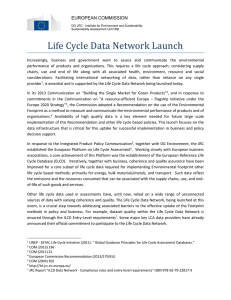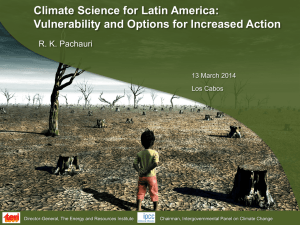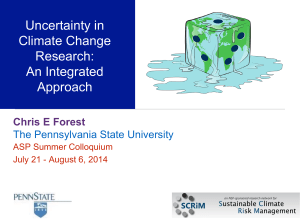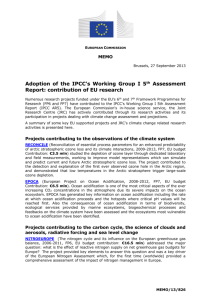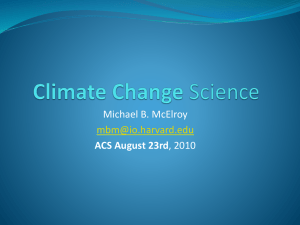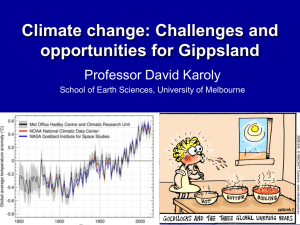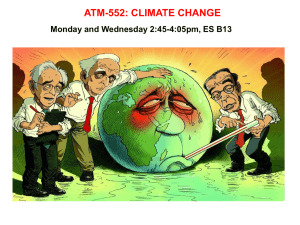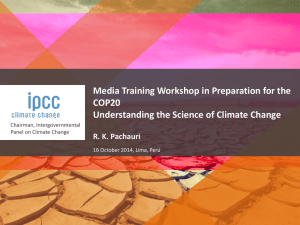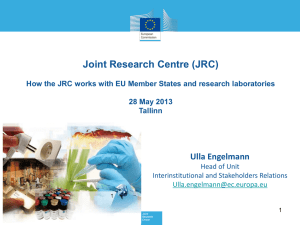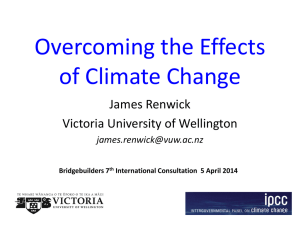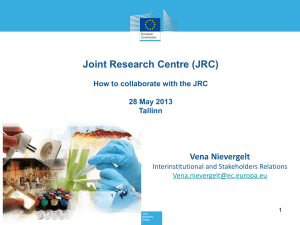Microsoft PowerPoint - Niemeyer_climateChange
advertisement
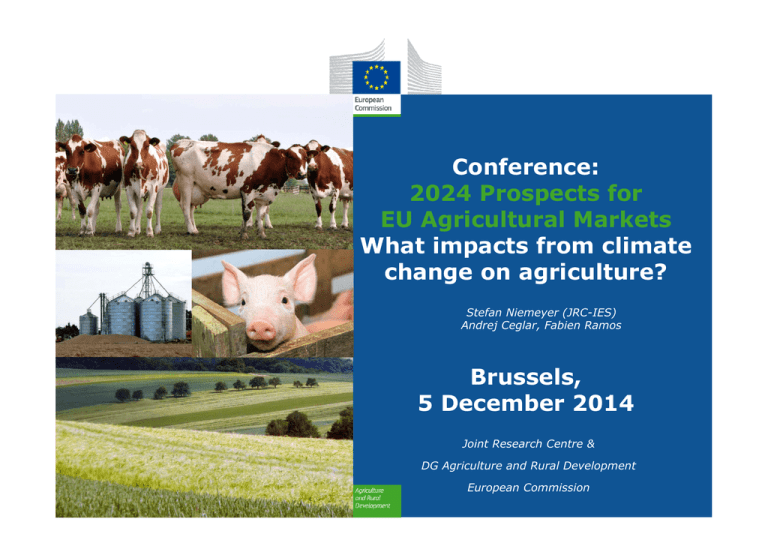
Conference: 2024 Prospects for EU Agricultural Markets What impacts from climate change on agriculture? Stefan Niemeyer (JRC-IES) Andrej Ceglar, Fabien Ramos Brussels, 5 December 2014 Joint Research Centre & DG Agriculture and Rural Development European Commission IPCC AR5 Intergovernmental Panel of Climate Change (IPCC) Fifth Assessment Report (AR5) published in 2013/14 • “Warming of the climate system is unequivocal.” Structure: • Observations – what has happened / is happening? • Projections – future climate scenarios • Impacts – observed and projected • Adaptation – reduce impacts, vulnerability, adaptation capacity • Mitigation – limit / reduce projected changes http://www.ipcc.ch/ 2 Observations IPCC AR5, 2014 3 Observations IPCC AR5, 2014 4 Observations The atmospheric concentrations of CO2, CH4, NOx have increased to levels unprecedented in at least the last 800’000 years. IPCC AR5, 2014 5 Observations Global, IPCC • Virtually certain that globally the troposphere has warmed since the mid-20th century (> 99% probability) • Total increase between the periods 1850-1900 and 2003-2012 is +0.78 ˚C [0.72-0.85] • In addition to robust multi-decadal warming, there is a substantial decadal and inter-annual variability in global mean surface temperature. • Very likely that the number of cold days has decreased and the number of warm days has increased on the global scale (> 90%) 6 Observations Europe, IPCC • Decadal average land surface temperature for 2002-2011 is 1.3 ˚C above the average of 1850-1899. • Warming has been strongest over Scandinavia in winter, the Iberian Peninsula warmed mostly in summer. • Since 1950, high-temperature extremes have become more frequent, while low-temperature extremes less frequent. • Likely that the frequency of heat waves has increased in large parts of Europe (> 66% probability). • Since 1950, annual precipitation has increased in Northern Europe and decreased in parts of Southern Europe. • Frequency or intensity of heavy precipitation events has likely increased in Europe (> 66% probability). 7 Observations Europe, JRC JRC 2014, MARS meteorological database Observations Europe, JRC JRC 2014, MARS meteorological database Observations Europe, JRC JRC 2014, MARS meteorological database Observations Europe, JRC JRC 2014, MARS meteorological database Observations Europe, JRC JRC 2014, MARS meteorological database Modelling Europe, JRC 1983-2013 1983-2013 JRC 2014, MARS meteorological database Observations Europe, JRC JRC 2014, MARS meteorological database Observations Europe, JRC JRC 2014, MARS meteorological database Attribution IPCC AR5, 2014 16 Attribution IPCC AR5, 2014 17 Future Climate • Emission scenarios of IPCC AR3,4 (A1, A1B, B2, …), now: • Representative Concentration Pathways (RCP): 2.6, 4.5, 6.0, 8.5 Defined according to the radiative forcing they create • Answer to the question: Which level of anthropogenic CO2 emissions required to achieve a given radiative forcing by 2100? … which translates into a respective surface temperature rise 18 Future Climate RCPs: 2.6: very low greenhouse gas concentration levels, substantially reduced greenhouse gas emissions over time. Peak in radiative forcing at ~3 W/m2 around mid-century and returning to 2.6W/m2 by 2100 4.5: total radiative forcing stabilized before 2100 at ~4.5 W/m2 by employment of a range of technologies and strategies for reducing greenhouse gas emissions 6.0: stabilization ~6 W/m2 after 2100 without overshoot by employment of a range of technologies and strategies for reducing greenhouse gas emissions 8.5: increasing greenhouse gas emissions over time leading to high greenhouse gas concentration levels; rising radiative forcing pathway leading to ~8.5 W/m2 in 2100. 19 Future Climate IPCC AR5, 2014 20 Future Climate IPCC AR5, 2014 21 Future Climate Global, IPCC Projected changes for global mean surface air temperature and global mean sea level, relative to the period 1986-2005 IPCC AR5, 2014 22 Future Climate Europe, JRC Weather scenarios – Air Temperature 23 Future Climate Europe, JRC Weather scenarios – Precipitation 24 Impacts agriculture Global, IPCC • Negative impacts of climate change on crop yields have been more common than positive impacts (high confidence). • For the major crops (wheat, rice, maize) [..] climate change without adaptation is projected to negatively impact production for local temperature increases of 2 ºC or more [..], although individual locations may benefit (medium confidence). • After 2050 the risk of more severe yield impacts increases. • All aspects of food security are potentially affected by climate change, including food access, utilization, and price stability (high confidence). • For most economic sectors, the impacts of drivers such as changes in population, age structure, income, technology, relative prices, lifestyle, regulation, and governance are projected to be large relative to the impacts of climate change (medium 25 confidence). Impacts agriculture Global, observed IPCC AR5, 2014 Summary of estimated impacts of observed climate changes on yields over 1960-2013 for four major crops in temperate and tropical regions, with the number of data points analyzed. 26 Impacts Agriculture Global, projected Projected changes in crop yields. 1090 data points from 42 studies, all regions, all scenarios, with and without adaptation. IPCC AR5, 2014 27 Agriculture, Global Adaptation IPCC AR5, 2014 28 Impacts Agriculture Europe, projected JRC 2013, crop model simulations 29 Agriculture, Europe Adaptation JRC 2013, crop model simulations 30 Conclusions • Climate change is being observed nowadays. • Global patterns of changing weather well understood. • Regional and local realization masked by high natural variability. • Changes in relevant agro-meteorological parameters observed. • Strong changes in climate expected beyond 2050, 2100 • Different outcome depending on scenario chosen • Time horizon of 2024 / 2030 less sensitive to scenario choice • Impacts on agricultural production depending on region and crop. • Northern Europe will benefit from warmer temperatures, southern Europe will suffer, if precipitation will be reduced. • Potential for adaptation at farm level considerable for 2030 horizon. • Overview level covered, context-specific, regional studies required. … thank you! info-agri4cast@jrc.ec.europa.eu Stefan.Niemeyer@jrc.ec.europa.eu 32
